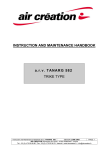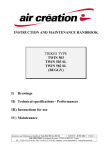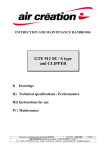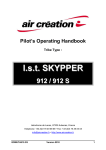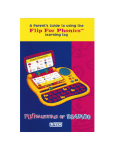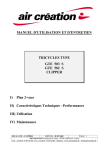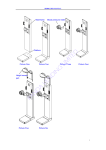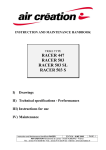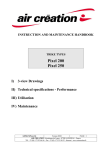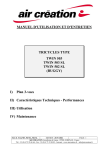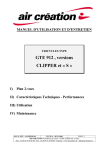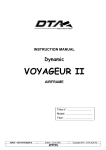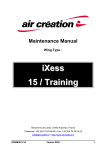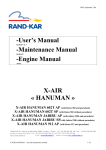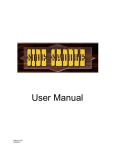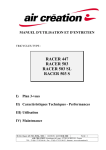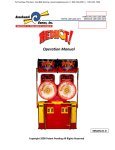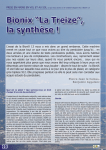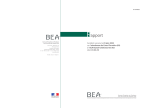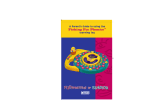Download INSTRUCTION AND MAINTENANCE HANDBOOK arv TANARG 912
Transcript
INSTRUCTION AND MAINTENANCE HANDBOOK a.r.v. TANARG 912 TRIKE TYPE Instruction and Maintenance Handbook a.r.v. TANARG 912 EDITION :JUNE 2005 PAGE : 1 AIR CREATION Aérodrome de Lanas - 07200 AUBENAS - France Tél. : 33 (0) 4 75 93 66 66 - Fax : 33 (0) 4 75 35 04 03 - Internet : www.aircreation.fr – [email protected] TABLE OF CONTENTS I) page Drawings II) Technical specifications – Performances 3 4 a) Summary III) Instructions for use a) b) c) d) e) f) g) h) i) j) k) Adapting wings and trikes Assembling Setting and functions of controls Ergonomics Preflight check Inboard settling Starting Takeoff Emergency procedures Options Specific use / security instructions 5 5 10 11 13 16 18 IV) Maintenance of the trike a) b) c) d) e) Transport Storage Running-in Propeller Periodical overhaul V) Use of the engine VI) Maintenance of the engine Instruction and Maintenance Handbook a.r.v. TANARG 912 EDITION :JUNE 2005 PAGE : 2 AIR CREATION Aérodrome de Lanas - 07200 AUBENAS - France Tél. : 33 (0) 4 75 93 66 66 - Fax : 33 (0) 4 75 35 04 03 - Internet : www.aircreation.fr – [email protected] 20 22 23 23 24 I) Drawings Overall length: 3000 mm Overall width: 2050mm Overall height: 2350mm Instruction and Maintenance Handbook a.r.v. TANARG 912 EDITION :JUNE 2005 PAGE : 3 AIR CREATION Aérodrome de Lanas - 07200 AUBENAS - France Tél. : 33 (0) 4 75 93 66 66 - Fax : 33 (0) 4 75 35 04 03 - Internet : www.aircreation.fr – [email protected] II) Technical specifications - Performances a) Summary 912 Empty weight (standard) 186 kg Maximum weight without wing 410 kg Ultimate load factors at max weight +6g -3g Limit load factors + 4g - 2g Fuel tank capacity 65 Liters Engine Rotax 912 Maximum power 59 kW Maximum rpm 5 800 rpm Reduction drive Mechanical Ratio 1/2.43 Maximum propeller rpm 2 400 rpm Measured noise level Lm at max. weight 72 dB Noise level corrected Lr 72 dB Height from ground H 95 m Minimum height from ground for a noise level inferior to 65 dB at maximum power 200 m To calculate the Lh loudness heard on the ground when the aircraft flies at the h height at maximum weight and maximum rpm, use the following formula: Lh = Lr - 22 log h H Instruction and Maintenance Handbook a.r.v. TANARG 912 EDITION :JUNE 2005 PAGE : 4 AIR CREATION Aérodrome de Lanas - 07200 AUBENAS - France Tél. : 33 (0) 4 75 93 66 66 - Fax : 33 (0) 4 75 35 04 03 - Internet : www.aircreation.fr – [email protected] III) Instructions for use a) Adapting wings and trikes Out of our current production, the two-seater wings iXess, Kiss 450 and Fun 450 are the only ones to equip a.r.v. TANARG trikes. b) Assembling • Lift the wing, rest it on its nose and into the wind. • Wheel the trike behind the wing, in the keel axis, take the windshield off, pull the upper beam down and take the front strut out. • Raise the upper beam, push the hang point into the hang bracket, position the Ø10 hang bolt, install the butterfly nut, tilt the lever back in order to tighten the plates, and secure with the safety ring. • Slip the back-up fastening cable through the belt loop at the kingpost level, make one turn around it. Slip it through the belt loop again and fasten it to the trike upper beam. The back-up fastening cable should pass under the tensioning cables. This operation secures both the trike to the wing and the wing crossbars tensioning system. • Raise the wing nose by pulling the trike back or by slipping the control bar until the keel meets the upper arch. • Attach the front strut between the plates at the top of the upper beam using the bolt, the butterfly nut and the safety ring. • Hold the control bar and lift the wing. The front tube base is fixed to the frame at windshield level. • Set the safety bolts of the upper beam (above the passenger seat) without forgetting the warning levers for locking, screw the butterfly nuts, then slip the safety rings into the drilling of the bolts. • Set the bolt connecting the front tube with the lower beam; screw the butterfly nut, and secure with the split ring. • Assemble the windshield using the ¼ turn bolts. • To disassemble, reverse the assembly operations. Instruction and Maintenance Handbook a.r.v. TANARG 912 EDITION :JUNE 2005 PAGE : 5 AIR CREATION Aérodrome de Lanas - 07200 AUBENAS - France Tél. : 33 (0) 4 75 93 66 66 - Fax : 33 (0) 4 75 35 04 03 - Internet : www.aircreation.fr – [email protected] c) Setting and functions of controls − Foot throttle Push the pedal to increase the power of the engine. Release it to reduce it. − Hand throttle This one is located on the right-hand side of the control panel. Push it forward to increase the power; pull it to reduce it. To make things easier we advise to use it along with the foot throttle, then to release it once the wanted r.p.m. has been reached. − Ground steering The steering bar operates the front wheel direction. Push the right pedal with your heel to turn left and vice versa. − Brake Push the left pedal forward to operate the brake upon the wheels. − Parking brake Push the brake pedal (brake action), lift the parking brake rack located on the left of the main panel and slowly release the brake pedal. The rack is blocked. A strong pressure on the brake pedal loosens automatically the parking brake. − Ignition switch and dual ignition selector The ignition switch is placed on the control panel and works once positioned upwards; it stops once positioned downwards. The dual ignition selector, also set on the control panel, allows choosing one out of the two ignition systems, whether in upward position, or downward position. The medium position allows for both. − Fuel cock It is located on the front of the fuel tank, left-hand side of the level indicator. The fuel cock is open when the lever is set parallel to the hoses, in the direction of the fuel flowing. The fuel valve is closed when the lever is perpendicular to the hoses. − Choke Set on a base plate under the right articulation of the upper arch, it allows starting the engine when cold. The choke is in use when the lever is perpendicular to the tube supporting it. d) Ergonomics − Pedal set In order to feel most comfortable and be in the best position for piloting, the position of the foot pedals can be adjusted. The range of adjustment of the rudder pedal is up to 16 cm (6.30 inches) with 6 positions following the horizontal plan. The rudder pedal is blocked in the selected position with a fast tightening bolt. Instruction and Maintenance Handbook a.r.v. TANARG 912 EDITION :JUNE 2005 PAGE : 6 AIR CREATION Aérodrome de Lanas - 07200 AUBENAS - France Tél. : 33 (0) 4 75 93 66 66 - Fax : 33 (0) 4 75 35 04 03 - Internet : www.aircreation.fr – [email protected] − Passenger footrest The footrest can be adjusted by pivoting on its axis once it has been unlocked. To do so, remove the locking pin allowing moving each foot clip by pulling it outwards, then put it back to place into the chosen position. − Pilot’s backrest The front seat backrest can be inclined in various positions thanks to both adjustable straps set along the bucket seat. The lower fixation on the frame can also be moved back for tall people. e) Pre-flight check • Check the wing as indicated in the user’s manual. • Check the trike-to-wing fastenings and every safety device (bolt, nut and split ring). • Check the front strut fastening on the front of the frame and on the upper beam (bolts, nuts and split rings). • Check the fastening of the upper arch on the back of the frame (bolts, nuts and split rings). • Check the propeller, the exhaust and its fastening springs, air filters and rubber mounts condition (engine + exhaust). • Check the fuel filter, the fuel valve and hose condition. • Check the coolant level in the expansion tank located behind the passenger seat and any leakage from hoses. Make sure the water cooler box is unobstructed and check the fixations of the whole part. • Check the oil level with the gauge placed in the bottle located on the engine’s left side, behind the rear strut’s shock absorber • If you suspect any water to be in the fuel tank (condensation, fuel quality) get rid of it with the help of the emptying system located on the right side, behind the passenger seat. To proceed to draining, open the trap of the luggage container, take the draining tube out and push the press-button. Fix the draining tube back into place after use. • Check the sidebags, the bag placed on the passenger seat while flying solo and the trap of the luggage container at the level of the water cooler’s right intake. f) Inboard settling − Pilot on the front seat Get on board by the left-hand side of the trike. The pilot should place his heel on the right pedal while holding the front strut with the left hand and resting his right hand on the articulation of the upper arch. The reverse operation is recommended to exit the trike. − Passenger Once the back of the pilot seat has been pulled down, the passenger embarks on the left of the trike by stepping the left foot on the passenger’s footrest and by holding the front strut with the left hand. Instruction and Maintenance Handbook a.r.v. TANARG 912 EDITION :JUNE 2005 PAGE : 7 AIR CREATION Aérodrome de Lanas - 07200 AUBENAS - France Tél. : 33 (0) 4 75 93 66 66 - Fax : 33 (0) 4 75 35 04 03 - Internet : www.aircreation.fr – [email protected] g) Starting • The ultralight has to be in a secure zone; make sure it is facing an unobstructed place while taking into account the effect of the blast of the propeller upon the surroundings. • Fill the fuel tank (please refer to the engine user’s manual for fuel details). The gauge is located on the right at the tank’s front. • Make sure the fuel valve is open (see the above paragraph « setting and functions of controls »). • Sit in the trike, on the front, parking brake engaged, safety belt closed. • Open the choke control (from cold). • Set the throttle lever and the foot pedal on “idle” position. WARNING: you must hear the throttle valve closing before starting the engine. Move the throttle lever back and forth to check that the piston on each carburetor returns to idle position. If you do not hear this noise, the reason may be a wrong adjustment or the cables may be stuck. In these conditions, you may lose the control of the aircraft and cause a serious accident, or even death, due to the strong push after starting. • Put the general ignition switch on the “on” position. • Make sure no one is standing close to the propeller and say out loud: “Clear prop” then turn the key of the master switch to the « start » position. Release the key once the engine has started. (Activate starter for max 10 seconds only, followed by a cooling period of 2 minutes). • Turn the choke down once the engine has been running a few seconds. • Adjust throttle to achieve smooth running at approx. 2500 rpm. The oil pressure must rise within 10 seconds and the warning light for battery charging must switch off. WARNING : for free cooling system engines (case of ROTAX 582 and 912), avoid a long continued ground-run to prevent overheating due to lack of airflow wind particularly if the outdoor temperature is high. Instruction and Maintenance Handbook a.r.v. TANARG 912 EDITION :JUNE 2005 PAGE : 8 AIR CREATION Aérodrome de Lanas - 07200 AUBENAS - France Tél. : 33 (0) 4 75 93 66 66 - Fax : 33 (0) 4 75 35 04 03 - Internet : www.aircreation.fr – [email protected] h) Takeoff − Prior to take-off • Your ultralight must be in good flight condition, that is to say maintained and • • • • • • • • • • used as prescribed in this handbook. The take-off weight must never exceed 450 kg. Check the red warning light for the correct lock of the upper beam is off. If the light is on, the upper beam is not properly locked. Stop the engine and get outboard to correct the problem (missing locking bolts or bad positioning of one small lever/clamp alongside the warning switch). Then resume the starting procedure as described in the paragraph g). Check the lower and upper bolts and safety rings of the front tube as well as the ones of the main hanging point wing/trike are placed properly and secure. Check seat belts fastening. WARNING: safety belts should be placed at hip level and tightened correctly. Safety belts fastened at abdominal level may cause internal injury in the event of a violent shock. Pull the buckle to release the winding system of the shoulder straps and fix it on the locating lug provided for this purpose, on the belt’s side. Check the fuel level in the tank and the opening of the cock. Check after the engine has warmed up both ignition systems by reversing the switch placed on the control panel. The test must be performed at 3000 rpm. The rpm drop must be less than 300 rpm with a difference of 120 rpm max between the two ignition systems. Put the switch selector back on the central position 1+2 after this test. Check general ignition switch by rapidly switching OFF and then ON. Check that the control bar moves freely in roll and pitch axis. Wait until the minimum parameters of engine temperature are reached. The TANARG 912 is equipped with an automatic carburetor heating system intended to help to prevent icing. This device uses the water of the cooling system of the cylinder heads to heat the carburetors’ intake. Wait until the water temperature in the cylinder heads reaches 80°C before taking-off to make it fully efficient. Release the parking brake by a short push on the brake pedal. WARNING: if the parking brake has been pressed too lightly and has not been released, the pilot may not feel its action during taxiing, but the takeoff distance will be much longer. − Takeoff Use progressively full throttle when carrying a passenger, with the foot throttle. When flying solo, 3/4 throttle will be enough for take-off and climbing. Use full power only under critical conditions (short takeoff runs, obstacles and high altitude flight). In that case never reduce or cut the engine below the 300 ft (100 m) altitude to avoid dynamic stalling. The recommended speed for initial climb is indicated in the wing’s manual. Instruction and Maintenance Handbook a.r.v. TANARG 912 EDITION :JUNE 2005 PAGE : 9 AIR CREATION Aérodrome de Lanas - 07200 AUBENAS - France Tél. : 33 (0) 4 75 93 66 66 - Fax : 33 (0) 4 75 35 04 03 - Internet : www.aircreation.fr – [email protected] − Cruising Keep the aircraft level with the throttle between ¼ and full power, depending on given airspeed. Avoid repeated and sudden power climbs and idle dives to prevent quick engine temperature changes, which could damage the engine by thermal shock. To avoid permanent pressure on the right foot throttle, push the hand lever on the right of the control panel until you reach a “hard point”, then release the pedal. To cancel the fitting, use the pedal then move the lever. Fuel tank content is easy to check from pilot’s and passenger’s seats as the tank has a side gauge. Landed shall be considered before tank content has reduced to 1.5 US gallons (5 liters). This allows approximately 30 minutes reserve of flight at economical cruising speed. − Landing The landing approach is best executed using the foot throttle pedal and both hands on the control bar. At maximum load, keep the throttle at ¼ of full power when on final to facilitate flare-out. Throttle back when the wheels touch the ground. The recommended approach speed is indicated in the instruction and maintenance manual of the wing. − Parking Place the aircraft across the wind and place the extremity of the half-wing in the wind on the ground. Stop the engine with the ignition switch. Cut the batterie power using the key. Block the parking brake. Block the control bar on the front strut of the trike using a Velcro®. Leave the trike, pilot first, then passenger, and always on the left side. Instruction and Maintenance Handbook a.r.v. TANARG 912 EDITION :JUNE 2005 PAGE : 10 AIR CREATION Aérodrome de Lanas - 07200 AUBENAS - France Tél. : 33 (0) 4 75 93 66 66 - Fax : 33 (0) 4 75 35 04 03 - Internet : www.aircreation.fr – [email protected] i) Emergency procedures − Power failure on takeoff Should the power unit fail after takeoff while still “at low height”, maintain aircraft control and safety approach speed, and land the aircraft straight ahead without attempting to turn back to the landing field. If time allows, set ignition switch off and fuel cock off. − Power failure at altitude If the engine fails for any reason, prepare for landing and carry out the emergency procedures as follow: • Immediately establish the best glide angle speed. • Check for suitable landing sites. Choose a number of preliminary options if possible. • Set ignition and battery switch off. Close the fuel cock. • Check pilot and passenger seat belts are tight and secure. • Check wind direction, either by natural indications such as smoke rising or by judging drift of aircraft over the ground. • Choose the most appropriate landing site. • Set up an approach as accurate as possible into wind. • Remember your aircraft cannot be heard. Check that no one is on the landing site. • Finalize your approach, deciding upon the best landing free of any obstacles. • Use a short landing technique. • Evacuate the aircraft as quickly as possible, inviting the second occupant to do the same. − Restart the engine in flight • Set the ignition switch to ON. • Use the choke in case of a prolongated stop. • Use the starter with the key. • Adjust the throttle and turn the choke off. WARNING: restarting in flight may be hazardous. Keep enough altitude and stay close to a landing field. − Engine fire Should an engine fire occur during flight: • Maintain your flying speed. • Set fuel cock off. • Set ignition and battery switch off. • Carry out the emergency landing procedures as above. Instruction and Maintenance Handbook a.r.v. TANARG 912 EDITION :JUNE 2005 PAGE : 11 AIR CREATION Aérodrome de Lanas - 07200 AUBENAS - France Tél. : 33 (0) 4 75 93 66 66 - Fax : 33 (0) 4 75 35 04 03 - Internet : www.aircreation.fr – [email protected] j) Options The standard empty weight used as reference to calculate the empty weight of the trike does not include the options stated hereafter. Thus it is necessary to retrieve from the useful load, detailed at the page 3 of the instruction and maintenance handbook, the weight of each option installed. 1) Parachute The Tanarg can be equipped with a pyrotechnic rocket parachute BRS, inside the special container placed under the passenger seat. The parachute will slow the descent of both aircraft and occupants if a major problem occurs (collision, flight envelope exceeded, etc.). It is advised to use it only as last solution to save life or reduce personal damages. Before starting the engine, the safety cotter pin placed on the launching handle should be removed. Then it should be replaced after landing, before going outboard, to avoid unintentional firing. It is recommended to link the engine key with the safety cotter pin, so its removal while using the trike cannot be forgotten. Before firing the parachute, it is advised, if altitude allows, switching the engine off to do not spoil the main bridle with the rotating propeller. If you cannot stop the engine, it will be stopped at the same time you pull the handle of the parachute, due to the switch integrated on the handle fitting. The activating of the rocket motor is made by pulling the red handle located between the pilot’s legs, on the seat frame. Warning: a strong pull on the handle is needed, at maximum available length. Always inspect bridle connection points and activation cables before flying; do not modify them. When rigging the wing, bridles must be fixed with the link shackle. The recommendations concerning inspection, activation and unloading of the rocket, maintenance periods and overall care are stated in the user’s manual provided with the parachute. The parachute does not change the flight behavior of the microlight but its weight reduces the useful load by 22 lbs (10 kg). 2) Dual control for instruction This option allows for control ot the ground steering and the engine power from the rear seat. It allows full control from the rear seat of the aircraft. Its weight reduces the useful load of the TANARG trike by 2.20 lbs (1 kg). 3) Towing system The towing system reduces by 2.20 lbs (1 kg) the useful load. It allows streamers, advertising signs and hang glider towing. Pull the lever, set on the left lower part of the seat frame, backward to release the towing cable. 4) Skis This option allows using the trike on packed snow after removing the wheels. The whole series of wings fit. The additional weight is up to 21 lbs (9.5 kg) and reduces the useful load of the trike by the same amount. Instruction and Maintenance Handbook a.r.v. TANARG 912 EDITION :JUNE 2005 PAGE : 12 AIR CREATION Aérodrome de Lanas - 07200 AUBENAS - France Tél. : 33 (0) 4 75 93 66 66 - Fax : 33 (0) 4 75 35 04 03 - Internet : www.aircreation.fr – [email protected] 5) HP : Hors-Pistes This option increases the possibilities of use on rough short fields and includes a hydraulic brake system on the 3 wheels with ultra-wide tires. Its weight is up to 20 lbs (9 kg) and reduces the useful load of the trike by the same amount. k) Specific use / security instructions 1) Towing − The towing line must include a fuse gauged at 80 daN maximum in order to allow an automatic releasing in case of over-tensioning. − Release the towing line above a fully clear ground before landing. − Test systematically the releasing device of the trike before taking-off. − The ideal speed for towing streamers is 47 mph (75 km/h). In the case of a glider, the speed should be adapted to its performances. The emergency procedures stated in chapter III i) remain applicable; the towing must be launched above a fully clear field prior to landing. Characteristics, listed in the chapter II c) of the concerned wing user’s manual, lessen due to the drag of towing and flying level requires a higher engine power. Minimum speed and stall speed remain unchanged. 2) Load carriage, survey material, data transmission, photography, video… − Install the loads to be carried on the passenger seat. The holding device has to support efforts up to 9 g forward, 3 g upward et 1,5 g laterally. − Limit the dimensions of the loads carried to avoid any contact, stress marks or blocking with the wing structure and particularly with the inferior longitudinal cables. − Mounting any kind of camera at the tip of the wing is possible up to a maximum weight of 2 kg if you install a counterweight at the extremity of the opposite wing. The inertia of the wing on its roll axis will increase. − The emergency procedures stated in chapter III i) remain applicable. 3) Sky jumpers − The place is always the back seat, such as in normal tandem or "sidesaddle", body perpendicular to the trike axis. − Cut the engine before the preparatory step of the jump. You may use the wheel leg gear as a step. − A training on the ground is absolutely necessary before taking-off. − The emergency procedures stated in chapter III i) remain applicable. If altitude allows, the sky jumper will seat back to “normal position” before landing. 4) Skis − Mounting the ski system in place of the wheels reduces the whole performances due to the increase of the drag induced. − The lack of brakes requires a perfect speed management and allows stopping only on a horizontal surface, engine off. − The emergency procedures stated in chapter III i) remain applicable. Instruction and Maintenance Handbook a.r.v. TANARG 912 EDITION :JUNE 2005 PAGE : 13 AIR CREATION Aérodrome de Lanas - 07200 AUBENAS - France Tél. : 33 (0) 4 75 93 66 66 - Fax : 33 (0) 4 75 35 04 03 - Internet : www.aircreation.fr – [email protected] IV) Maintenance a) Transport The trike should preferably be transported on a light trailer. Stowing can be made with fastening straps on the wheels. The propeller should be whether disassembled or blocked in rotation with a strap. A protection with a plastic wrap or a cover, tensed to avoid flapping, will avoid irremediable staining from haulage due to exhaust gas. b) Storage The trike unit should be thoroughly checked and cleaned prior to storage. After cleaning, wipe all components with a clean lightly oiled cloth, while avoiding joints and rubberized parts. Storage –off-storage if unused a long time It is recommended to dismantle the wing from the trike in case of a long storage for several months. Fold it properly, in respect with its manual, to loosen the tensions and to protect it from ultraviolet rays. For the trike, you only need to place a cover or a sheet upon it and to prepare the engine according to the user’s manual chapter IV. Reverse the operation to use it and make a single-seater local flight test before using the aircraft as usual. If the trike has to be stored for a long period (i.e. 2–3 months): empty the whole fuel system in addition to the above operations. c) Running in Your trike’s engine has been factory-tested and pre-tuned but it requires running in and sometimes final tuning. The engine should be run in on the ground as stated in the engine user’s manual in chapter 9. Warning! Check the water temperature and stop the procedure if it reaches 176°F (80°C) to let the engine cool down. We recommend to running in the engine in flight with no passengers. d) Propeller Pitch of the propeller The pitch of the propeller is adjusted for standard use. However the pitch of the ARPLAST propeller can be adjusted according to the wing used and the air density. A maximum ground speed of 5 400 rpm is recommended for all the wings, except the iXess which requires a maximum of 5 200 rpm in order to prevent over-revving at full speed. Use the special tool and the ARPLAST manual to modify the pitch. NEVER FLY USING AN UNBALANCED PROPELLER due to a shock or any projection. Vibrations generated will damage the reduction gear and the trike frame. To check propeller balance: remove the propeller and hang it by the the hub center, free to rotate (see your dealer). If unbalanced, it should be returned to the factory for repair. Instruction and Maintenance Handbook a.r.v. TANARG 912 EDITION :JUNE 2005 PAGE : 14 AIR CREATION Aérodrome de Lanas - 07200 AUBENAS - France Tél. : 33 (0) 4 75 93 66 66 - Fax : 33 (0) 4 75 35 04 03 - Internet : www.aircreation.fr – [email protected] e) Periodical overhaul For the engine, refer to chapter 9 of the engine maintenance manual. Often clean the radiator to avoid obstruction due to grass or debris. − Every 50 hours of flight time or 6 months (first achieved): • Check the engine support: rubber mounts and fastening springs. • Check seams on welded assemblies, corrosion*, cracks, holes, movement on various assemblies (engine support, front frame, back frame, upper beam, gear triangles, front fork, pedal assembly, fairing fastening, coolers). * Corrosion: the trike structure is made of stainless steel 304 and 304L. This type of steel, in spite of its denomination, is sensitive to corrosion, particularly around welding seams. The structure is protected by a highly resisting coating (oven-heated epoxy). The happening of corrosion makes blisters and takes the finish off. It is necessary to treat immediately the corroded patches by scraping, cleaning and then protecting them. In hostile environment (notably sea), the corrosion may appear and grow faster, so it should be checked more frequently. • Check rear shock absorber air pressure. Insufficient pressure will cause the trike suspension units to subside under load or lean excessively during turning on the ground or in cross-winds. Fill to 25 bar using a special hand-pump where required or ask your dealer. • Every 25 landings maximum, check the length of the sliding tubes of the “shock absorber” set. The difference (sets at full extension) should not exceed 2 mm. If not, you should arrange for an overhaul. Moreover the overhaul of the “shock absorber” set has to be made every 400 take-off or 3 years of use. • Check condition and running of throttle, brake and fork control cable. Warning: never put grease or oil on cables; a self-lubricating « POM® » sheath keeps them working properly. − Every 100 hours of flight time: • Change hoses and fuel filter. • Change throttle, brake and fork control cables, all bolts involved in frequent mounting/dismounting operations (hanging point, front strut and upper arch), engine and propeller mounting bolts. • Change the 2 front wheel shock absorbers. • Change the lower and upper bearings of the front fork. • Check condition of tires, rims, and wheel bearings front fork and wheel axles. • Check condition of brake discs as well as brake pads. • Check level of brake’s liquid in each pump. • Check upholstery, seams of under-seats, back of seats fastening. • Check the front strut at lower and upper fixations level. Instruction and Maintenance Handbook a.r.v. TANARG 912 EDITION :JUNE 2005 PAGE : 15 AIR CREATION Aérodrome de Lanas - 07200 AUBENAS - France Tél. : 33 (0) 4 75 93 66 66 - Fax : 33 (0) 4 75 35 04 03 - Internet : www.aircreation.fr – [email protected] − After any heavy landing: • Check the front fork, remove and inspect the fork pivot and fork connecting arm–wheel axis. • Check the frame tubes and sheets for distortion and control the under-seat seams. • Check the upper beam and the front strut (play, folds and cracks), the engine support and the engine mounting rubber mounts and springs. • Check the rear gear, loosening of assembly devices, and shock absorber air pressure. If the sail has bumped the ground, even slightly, proceed to a complete disassembly and a thorough check of the structure, by an authorized technical station or by the factory workshops. WARNING: All the Nylstop® nuts must be replaced after each disassembly. Always secure such nuts using specific LOCTITE® glue. Instruction and Maintenance Handbook a.r.v. TANARG 912 EDITION :JUNE 2005 PAGE : 16 AIR CREATION Aérodrome de Lanas - 07200 AUBENAS - France Tél. : 33 (0) 4 75 93 66 66 - Fax : 33 (0) 4 75 35 04 03 - Internet : www.aircreation.fr – [email protected] PERIODICAL OVERHAULS BOARD Serial number: Date Hours flown Company which has carried out the overhaul Address and stamp Instruction and Maintenance Handbook a.r.v. TANARG 912 EDITION :JUNE 2005 PAGE : 17 AIR CREATION Aérodrome de Lanas - 07200 AUBENAS - France Tél. : 33 (0) 4 75 93 66 66 - Fax : 33 (0) 4 75 35 04 03 - Internet : www.aircreation.fr – [email protected] PERIODICAL OVERHAULS BOARD Serial number: Date Hours flown Company which has carried out the overhaul Address and stamp Instruction and Maintenance Handbook a.r.v. TANARG 912 EDITION :JUNE 2005 PAGE : 18 AIR CREATION Aérodrome de Lanas - 07200 AUBENAS - France Tél. : 33 (0) 4 75 93 66 66 - Fax : 33 (0) 4 75 35 04 03 - Internet : www.aircreation.fr – [email protected] Notes Instruction and Maintenance Handbook a.r.v. TANARG 912 EDITION :JUNE 2005 PAGE : 19 AIR CREATION Aérodrome de Lanas - 07200 AUBENAS - France Tél. : 33 (0) 4 75 93 66 66 - Fax : 33 (0) 4 75 35 04 03 - Internet : www.aircreation.fr – [email protected] TRIKE – QUALITY FORM Anxious to ensure the perfection of our products, we have set a sequence of controls covering all the steps of production. We are working continuously on their improvement and we are in need of your help. Please return this reply form accurately filled if you find any mistake or problem concerning your trike, which could affect its quality or finish, even if it is a minor one. Your name, address and telephone number : Type : Delivery date : Trike number : Engine serial number : Distributor : Hours flown : Problems noticed : (explanations and / or drawing) Instruction and Maintenance Handbook a.r.v. TANARG 912 EDITION :JUNE 2005 PAGE : 20 AIR CREATION Aérodrome de Lanas - 07200 AUBENAS - France Tél. : 33 (0) 4 75 93 66 66 - Fax : 33 (0) 4 75 35 04 03 - Internet : www.aircreation.fr – [email protected]




















